SWAPPING ARENAS
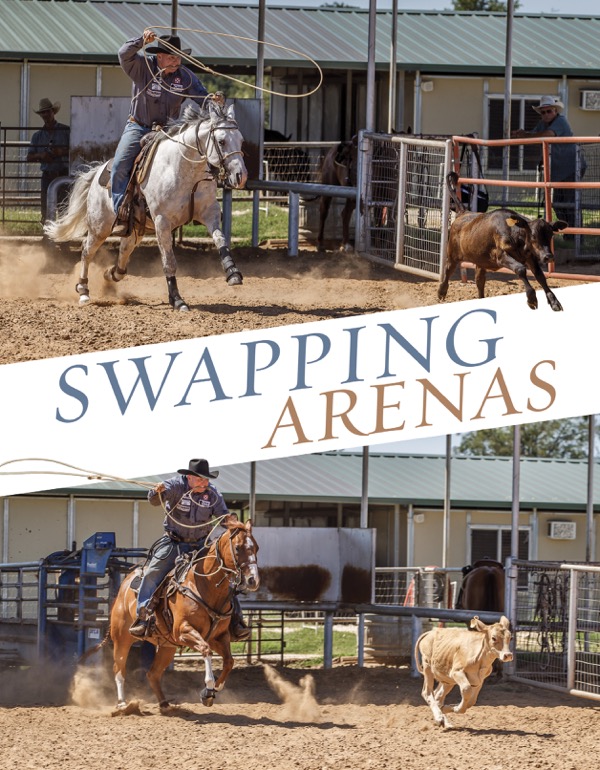
Trainer James Barton discusses the differences between rodeo and AQHA competition tie-down roping, and how to transition your horse between the two.
Article and photos
by Abigail Boatwright
by Abigail Boatwright
At first glance, one might think tie-down roping is exactly the same in AQHA competition as it is in rodeo. The actual mechanics of a run are identical. But to win, there’s a distinct difference between what the two types of competition require. It’s possible for your horse to do both, but you’ll need to hone his skills for each arena. Trainer James Barton has done just that with many horses, guiding his horses to both AQHA world championships and on into the hands of elite rodeo competitors such as Tuf Cooper, Trevor Brazile, Marty Yates and Matt Shiozawa, just to name a few. Horses that James has trained have won numerous Wrangler National Finals Rodeo titles and a bunch of money.
Similarities
The basic rules of tie-down roping are the same for both sports. After the calf is released from the chute, the horse and rider break from the box and chase the cow into the arena. Once the rider has roped the calf, the horse stops, rider dismounts and runs down the rope to the calf. He’ll flank the calf and tie three of its legs together with another rope to conclude the run.
“You still have to rope the calf, you still have to tie it down,” James says. “However, the styles are changing.”
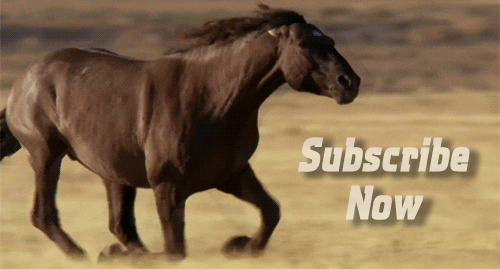
In June 2015, the Professional Rodeo Cowboys Association introduced a rule that allows rodeo committees the ability to implement a no-time for a jerk-down.
“Rodeo horses now need to stop with more of a slide, like a show roper, to conform to the stronger ‘jerk down’ rules present in today’s rodeos.”
Differences
Travel
The rodeo life for a horse is much different than horse-show life, says James. An AQHA competitor may attend 10 shows in a year, while a rodeo mount could top 100 rodeos in the same amount of time. And accommodations are also different.
“At horse shows, they get stalled in really nice barns, whereas if you’re a rodeo horse, staying in the same town for 24 hours is unusual,” James says. “A rodeo horse spends much of the time in the trailer versus a stall.”
Atmosphere
The action around the arena and grounds is different, too. Rodeos are a big production, with crowds, sights and sounds that could be overwhelming for a horse used to a more sedate AQHA horse show.
“At horse shows, there’s a golf clap at the end of your run, not a rock show,” says James.
Scoring
The biggest difference between the two arenas is how the run is scored. A rodeo tie-down roping run is based strictly on time – the fastest time roping the calf, with fewest penalties, wins. The rider can throw two loops, but time is of the essence – the calf must be roped in 25 seconds or less.
“The horse has to be really quick and fast,” James says. “Their demeanor has to be low-key but then can rise to the occasion. Because of their travel schedule, and all the hoopla that goes on at the rodeo, you have to have a horse that can handle all of that and not get hyped up.”
Scoring for tie-down roping is different in AQHA competition. In fact, the actual time has little bearing on the score. AQHA rules state that the run needs to be completed in one-minute’s time, and the rider can throw a maximum of two loops during that run.
“Horses don’t have to be as perfect in rodeo as they do at a show,” James says. “You go through all the same maneuvers, but the horse show run is judged on how well the horse performs those maneuvers, not the time. The time has nothing to do with it. We want to be able to demonstrate all four maneuvers: the box or scoring, running and rating, the stop, and working the rope. You need enough time to do that, not just rope the calf as fast as you can.”
A rodeo horse has to do his job; looks come second. But James has found that show horses, because they’re also judged on eye appeal, score well if they’re real lookers.
“An AQHA horse should be conformationally pretty. You want a pretty mover, a horse that can slide a bit through its stops, with fluid maneuvers,” James explains.
AQHA show horses tend to be quite trainable and versatile, because they usually do more than one event, says James.
“A show horse may do all the roping events, plus some of the other classes like working cow horse or Versatility Ranch Horse,” he adds.
EQUIPMENT
Some tack and equipment is allowed in PRCA competition but not AQHA. One example is a jerk line, commonly used in rodeo, but is not allowed in AQHA competition.
A jerk line is a length of rope running from the bit to a pulley on the saddle and then is tucked into the rider’s belt in a set of loose loops. As the rider runs to the calf, the tension of the jerk line releases from the belt, encouraging the horse to work the rope.
To illustrate the differences between show and rodeo horses, the sorrel horse in this article, CSR Big Smokin Jake, is pictured with a jerk line.
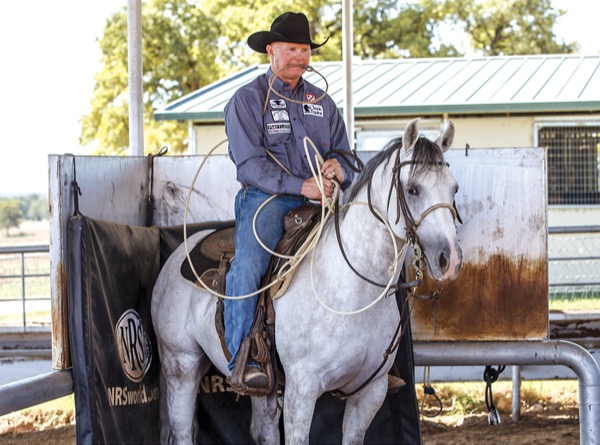
A show horse needs to stand quietly in the box with slight slack in the reins, responding to a leg cue to leave the box.
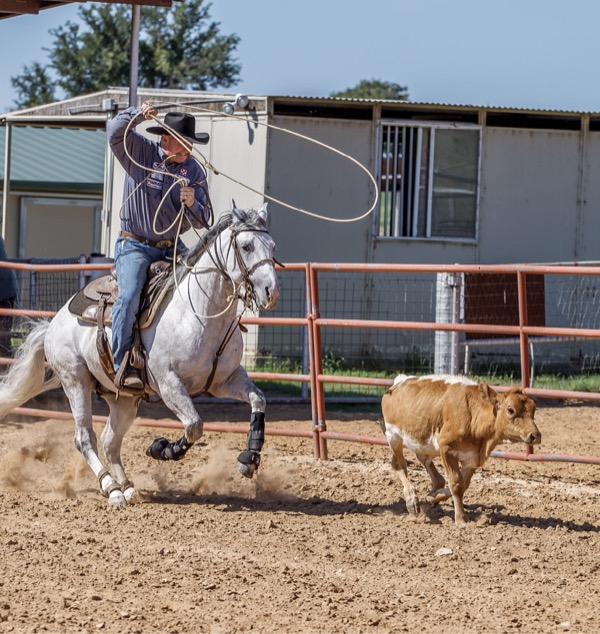
A rodeo horse needs to exit the box as quickly as possible to reach the calf, so the rider holds contact on the reins and releases the reins to take off. The rodeo horse also stands closer to the barrier than a show horse.
Age
Rodeo horses tend to be 10 years old and up, while AQHA show horses excel at the 4- to 8-year-old range, says James.
“Rodeo competitors want a more consistent horse – they want the horse to do the same thing every trip,” James says.
With AQHA competition, there are divisions for junior horses – 5 years and younger – and senior – 6 years and over. So there are classes for rope horses to start out as a younger horse and gain experience and training as they age.
Equipment
The equipment worn by show horses is sometimes different from a rodeo mount, says James. The AQHA Official Handbook of Rules and Regulations outlines permissible equipment, while rodeo horses only require a neck rope and have fewer restrictions. James say a jerk line is commonly used in rodeo, but not AQHA competition. A jerk line is a length of rope running from the bit to a pulley on the saddle and then is tucked into the rider’s belt in a set of loose loops. As the rider runs to the calf, the tension of the jerk line releases from the belt, encouraging the horse to work the rope.
Box and Barrier
A show horse needs to be quiet in the box, so James usually takes some time there to show off that quality in the horse. The horses are trained to take off in response to leg cues with slight slack in the reins.
A rodeo horse needs to be as quick as possible out of the box to allow the rider to reach the calf to rope it in seconds. The rider holds contact on the reins, and when released, the horse takes off out of the box quicker than a show horse’s kickstart.
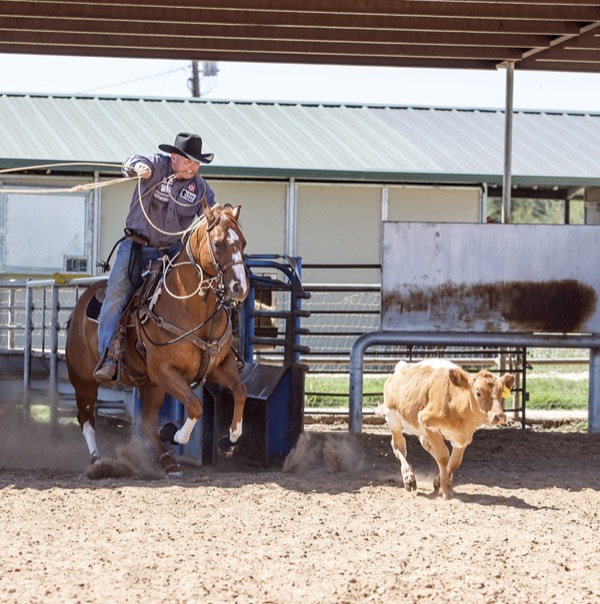
An AQHA tie-down roping run should demonstrate your horse’s ability to trail the calf, matching its speed.
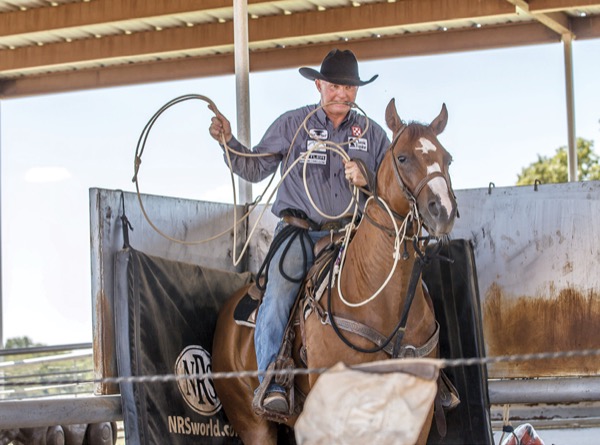
A rodeo run needs to be quick and fast, typically roping the calf much quicker.
Running and Rating
Part of a tie-down roping run includes chasing the calf down, trailing the calf and matching its speed. At a horse show, James says you want to really demonstrate your horse’s abilities to do this, perhaps running 50 feet out into the arena – while a rodeo horse tracks the calf for less time, since the run needs to be quicker.
“A slower horse that is correct might not have the quickness, but it can still win (at a horse show),” James says. “In rodeo, we want them to be quick, fast, and they don’t track the calf very long – the horse may not even know the calf has been roped because it’s happened so fast.”
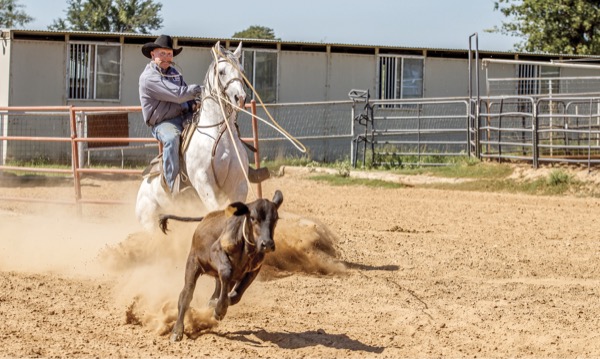
A show horse needs to execute a pretty, fluid stop and, typically, the rider pitches the rope at the calf while cueing with the reins to help the horse stop.
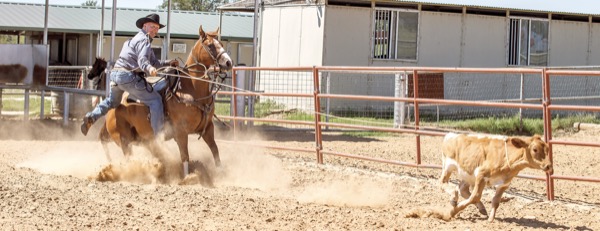
A rodeo horse also needs to stop softly, but on its own, without rein cues, while the rider is dismounting and running down the rope.
The Stop
A show horse should execute a nice, pretty, fluid stop, says James. The rider pitches the slack in the rope at the cow while cueing with the reins to help the horse perform the stop.
In the past, for a rodeo horse, a quick, hard stop was common. But today, the calves are smaller, quicker and lighter than in years’ past, and a soft stop has become more important. Plus, a too-hard stop that knocks the calf over will cost you time getting the calf back on its feet before you flank it. That’s why James says the rope horse needs to slide into the stop to soften the impact.
James says a rodeo rope horse needs to be able to stop on its own, without rein cues, as the rider is bailing off and running down the rope.
Working the Rope
A show horse should work the rope while the rider flanks the calf and ties it, says James. This starts with backing about six steps to take up any slack in the rope.
“You want them to pull the rope tight enough that you can flank the calf, but once you get the calf on the ground, you want the horse to pull the rope taut without overworking it or pulling it too much,” James says.
A rodeo horse, in contrast, backs three steps or less – whatever is needed during the short time the rider is tying the calf.
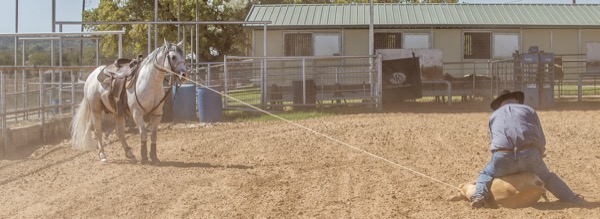
A show horse should work the rope by backing up to six steps while the rider is flanking the calf and tying it.
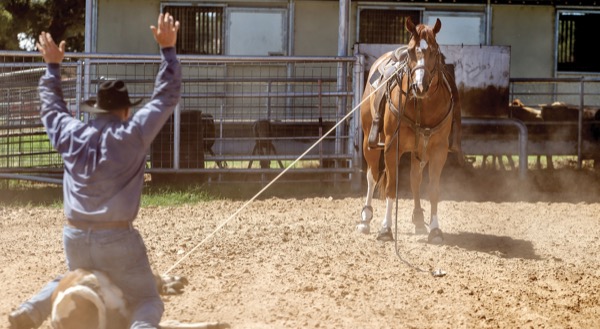
A rodeo horse will most likely back three steps or less.
How to Transition
James says success in one arena doesn’t guarantee success in the other.
“Some of the best rodeo horses have been horrible show horses, and some of the best show horses have not been good rodeo horses,” James says.
From AQHA to Rodeo
To step into the rodeo arena with a show rope horse, James focuses on stepping up the horse’s quickness out of the box, and making each run a solid performance.
“I try to make them a lot quicker and a lot more consistent so there is no difference from one run to the next,” James says.
Show horses also need to become accustomed to the equipment in rodeo, and most importantly, the atmosphere. Seasoning is a key element to the transition, says James.
“I’ll take them to events and rodeos,” James says. “I’ll take them to jackpots, where there’s more going on instead of a quiet atmosphere. We’ll move up to smaller rodeos and amateur rodeos to expose the horse before we spend a lot of money putting the horse out into the world (at bigger rodeos).”
From Rodeo to AQHA
For a rodeo horse to excel in the show pen, he needs the right mental attitude – mainly, trainability. Not all horses can do it, says James. He’ll work with a rodeo horse to perfect each part of the run, making sure it’s technically correct and pretty versus lightning-fast.
Some horses can do both arenas. James says the hardest transition is going from the rodeo to a horse show.
“Good, well-trained horses can do both,” James says. “Sometimes a horse that can do multiple events can have a hard time swapping back and forth.”
He recommends spending some time with an AQHA Professional Horseman to hone your horse’s rodeo-roping skills to fit AQHA competition.
“An AQHA Pro Horseman can help you learn the rules and the showmanship to demonstrate your horse at its best,” James says. “It’s a judged event and it needs to look pretty. You’ll be judged on your actions from the time you step foot into the arena, to the time you step out – not just when you nod your head to when you put your hands up.”
Abigail Boatwright is a special contributor to AQHA Media. To comment on the article, email aqhajrnl@aqha.org.
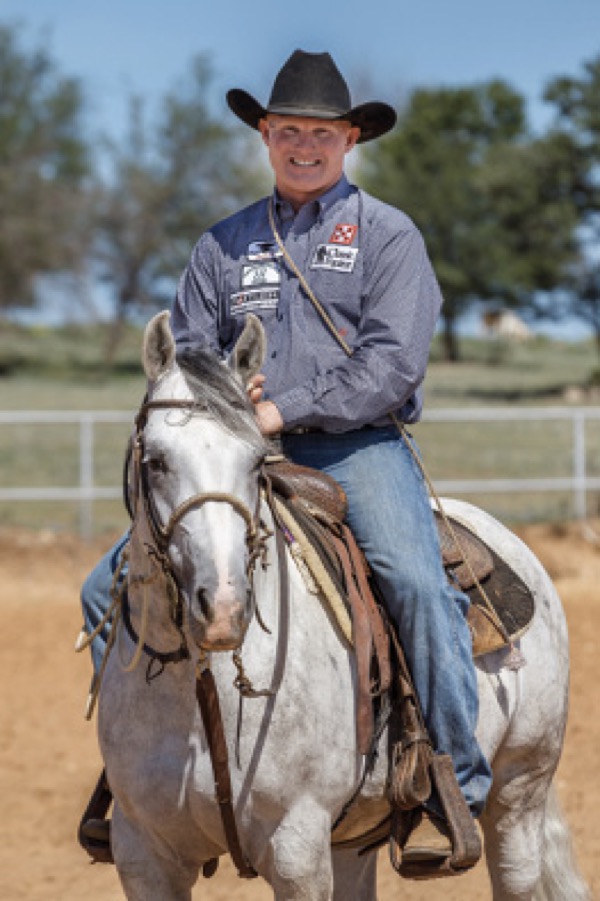
JAMES BARTON
AQHA world champion JAMES BARTON of Bluff Dale, Texas, specializes in tie-down and team roping horses. He trains great Professional Rodeo Cowboy Association competitors such as Tuf Cooper’s “Topaz” (Big Smokin Otoe), and the gray horse pictured here, AQHA world champion Mamas Duel N At Boon. Also pictured in this article is CSR Big Smokin Jake, a former AQHA show competitor now competing in rodeos.

